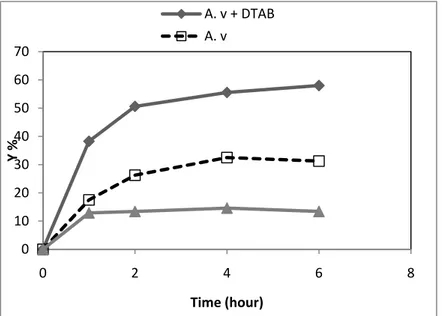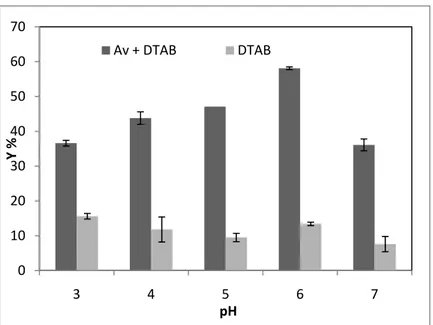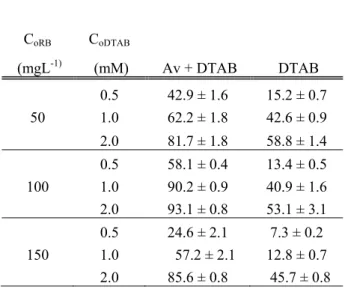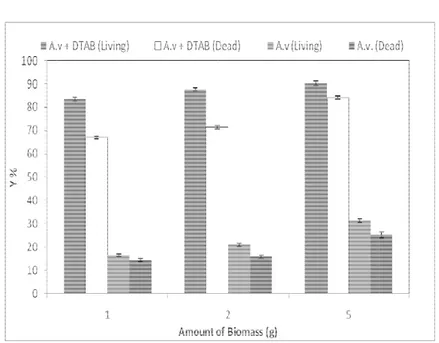EFFECT OF A CATIONIC SURFACTANT ON DYE BIOSORPTION PROPERTIES OF Aspergillus versicolor
ÜLKÜYE DUDU GÜL and GÖNÜL DÖNMEZ *
Ankara University, Science Faculty, Department of Biology, 06100 Tandogan/ANKARA
e-mail:gdonmez@science.ankara.edu.tr
(Received September 09, 2010; Accepted November 02, 2010)) ABSTRACT
The effect of a cationic surfactant Dodecyl thrimetyl amonium bromide (DTAB) on Remazol blue dye bisorption properties of living and dead A. versicolor biomass was investigated in this study. The effect of surfactant on biosorption and the functions of pH, dye and surfactant concentration was examined. Dye removal of fungal biomass was 58.1 % in the presence of 0.5 mM DTAB and 31.3 % in the absence of DTAB after incubation for 6 hours. In order to determine the optimal pH value, pH 3 to 7 with 0.5 mM DTAB was examined and the maximum biosorption was occurred as 58.1 % at pH 6 in 100 mg L-1 dye. To examine the effect of
surfactant and dye concentration on bioremoval the surfactant concentration was varied from 0.5 to 2 mM and dye concentrations were 50,100 and 150 mg L-1. Dye
uptake by fungal biomass increased with an increase in surfactant concentration. To understand the dye removal activity of only fungus in the presence of DTAB, the dye removal value of only DTAB have been subtracting from the dye removal value of fungus with DTAB. The results showed that cationic surfactant DTAB enhanced dye biosorption by A. versicolor. The removal process used in this study is also a new approach and has a high value to remove reactive dyes from wastewater.
KEYWORDS: Surfactant; Reactive dye; waste water; biosorption; A.
versicolor
INTRODUCTION
Reactive dyes are commonly used in textile industry in Turkey because of some advantages such as easy to use and cost effective in synthesis process.
The discharge of waste water that contains high concentrations of reactive dyes is a well-known problem associated with dyestuff activities. The presence of very low concentrations of reactive dyes in the effluents is visible 1. Some dyes have a potential of mutagenity 2, carcinogenity and toxicity 3. It is difficult to remove reactive dyes by using conventional waste water treatment methods because of their resistance to degradation 4, 5. To decolorize these wastewaters some biological methods can be applied with using various microorganisms like bacteria, algae and fungi 6. Recent researches on biological decolorization have focused on fungal strains as
Phanerochaete chrysosporium 7, Trametes versicolor 8, Coriolus versicolor
9, 10 and Rhizopus arrhizus 11, 12. There is a study that have shown the
effective remazol blue removal capacity of growing A. versicolor 13. However, there is no report about biosorption of dye by living A. versicolor biomass.
The amphiphilic molecules surfactants possess both hydrophilic and hydrophobic parts 14. The hydrophilic part is called the head and the hydrophobic portion is the tail (or tails) of molecule. The hydrophobic part may consist of a single chain or it may have up to four chains. The head can be a charged or uncharged polar group. According with the nature of the head groups the surfactants are classified into anionic, cationic, non-ionic and zwittterionic (amphoteric) 15. Surfactants are used as leveling agents in dyeing stuff 16. Recently, the usage of surfactants in dye removal from waste water treatment gains importance 17, 18. There isn’t any study using surfactants as an inducer to reactive dyes removal by A. versicolor biomass. The goal of this work was to study the effect of Dodecyl trimethyl ammonium bromide (DTAB) cationic surfactant on removal of Remazol Blue by A. versicolor. To our knowledge this is the first report correlating surfactatnt effect on dye biosorption properties of A. versicolor in a very effective way.
MATERIALS AND METHODS Microorganism and growth conditions
The fungus used in this study, A. versicolor was isolated from soil samples from Batman, Turkey 13. The microorganism was cultivated in liquid molasses media using the shake flask method. The growth molasses
medium consisted of beet molasses solution (approximately equivalent to 10 g L−1 sucrose), 1.0 g (NH
4)2SO4, 0.5 g KH2PO419. pH of the medium was adjusted to 6 with dilute H2SO4 and NaOH solutions after autoclaving. Once inoculated, flasks were incubated on a rotary shaker (New Brunswick Scientific Innova 4230) at 100 rpm for 5 days at 25 ± 1 oC
After the growth period, biomass was harvested from the medium, washed with distilled water, and then filtered to remove water. For the biosorption studies, 5 g of fresh living biomass was added in to l00 ml of solution containing a known concentration of Remazol Blue or a desired combination of Remazol Blue and DTAB in an Erlenmeyer flask at a defined pH value. To show the biomass effect on biosorption, both living and dead biomass was added in to flasks. Dead biomass was prepared with autoclaving the filtered cell at 121 oC for 15 mins.
Preparation of Remazol Blue and surfactant solutions
Remazol Blue was obtained from Aytemizler Textile Co. in pure form. The dye stock solution was prepared by dissolving the powdered dyestuff in distilled water to a final concentration of 2 % w/v. An appropriate volume of the stock solution was added to the media.
The cationic surfactant Dodecyl thrimetyl amonium bromide (DTAB) (CH3(CH2)11N(Br)(CH3)3, MW: 308.34 g mol-1) was supplied from Fluka. Stock surfactant solutions were prepared from surfactant, at 1.0 g L-1 concentration by dissolving weighed amount in double-distilled water. Appropriate volumes of the stock solutions were added to the media.
Biosorption experiments
Biosorption studies were carried out in a routine manner by the batch technique in 250 ml Erlenmeyer flasks containing 100 ml distilled water that included dye or dye and DTAB at desired level of each component at the beginning of the experiments. The flasks were continuously shaking in a rotary shaker at 100 rpm and 2 ml of samples were taken every 2 hours during 6 hours period. Before analysis the samples were centrifuged at 10000 rpm for 10 min and the supernatant fraction was analyzed for the
remaining dye. Studies were performed at a constant temperature of 25 ± 1oC to be representative of environmentally relevant conditions.
To examine the effect of surfactant on bioremoval, the flasks including 100 ml distilled water, 100 mg L-1 dye and 0 and 0.5 mM DTAB were prepared at pH 6. The effect of pH was investigated with pH values of 3, 4, 5, 6 and 7 with 100 mg L-1 dye and 0.5 mM DTAB. In order to determine the effect of dye and surfactant on bioremoval, dye concentration was varied from 50 to 150 mg L-1 and surfactant concentrations were varied from 0.5 to 2 mM. To examine the effect of living and dead biomass, 1, 2 and 5 gr of fresh living and dead biomass was prepared. Dead biomass was prepared with autoclaving (121 oC for 15 mins) the filtered cell. The dead and living biomass was transferred in to 250 ml Erlenmeyers containing 100 mg L-1 dye in the presence and absence of 1 mM DTAB. The experiments were also repeated with the flasks containing no fungus, but the dye and DTAB at desired levels to observe any interaction between the dye and DTAB. All the biosorption experiments were performed in triplicate.
Analytical methods:
Concentration of Remazol Blue dye in the solution (diluted properly) was determined spectrophotometrically by using a UV/VIS spectrophotometer (Labomed Inc, USA). The absorbance of the color was measured at 600 nm where the maximum absorption peak exists. Absorbance measurements and centrifugation were performed using a Shimadzu UV 2001 model spectrophotometer and Med. Instruments MPW- 351 R model centrifuge, respectively.
RESULTS AND DISCUSSION
The effect of surfactant on dye bioremoval properties of A. versicolor biomass was investigated as a function of initial pH, dye and surfactant concentrations and living and dead biomass. The percentage uptake of dye was calculated from
Eq. ( 1): dye decolorization (%) = (Co – Cf) /Co x 100
The uptake of dye by unit mass of fungus at any time (qm) was determined
Eq. (2): qm = Co – Cf / Xm (2)
where Co is the initial Remazol Blue concentration (mg L-1), Cf is the final Remazol Blue concentration at any time (mg L-1) and X
m is the dry weight of fungus (mg g-1).
Effect of surfactant (DTAB) on biosorption
The effect of DTAB on decolorization of dye was investigated in samples having about 100 mg L-1 initial dye concentrations in the presence and absence of 0.5 mM DTAB at pH 6 after incubation for 6 hours. Fig. 1 showed dye removal capacity of fungal biomass.
Figure 1. The effect of surfactant on Remazol Blue biosorption yield (Y %) of A. versicolor (A.v.) at about 100 mg L-1 initial dye concentrations. (T: 25 ± 1°C; Stirring rate: 100 rpm; A.v: A.
versicolor; A.v. + DTAB: A. versicolor with 0.5 mM DTAB;
DTAB: 0.5 mM DTAB) 0 10 20 30 40 50 60 70 0 2 4 6 8 Y % Time (hour) A. v + DTAB A. v
According to the data obtained that fungus showed more dye biosorption activity in the presence of 0,5 mM DTAB than in the absence of DTAB. Dye removal was 58.1 % in the presence of surfactant, it was 31.3 % in the absence of surfactant and 13.4 % in the presence of surfactant without fungus. The biosorption process was about two times higher in the presence of surfactant than in the absence of surfactant. According to this data, biosorption of Remazol Blue by A. versicolor was enhanced by cationic surfactant (DTAB). Aksu et. al. (2010) showed that the anionic surfactant Sodium dodecyl sulfate (SDS) enhanced the cationic dye Methylene Blue biosorption by the filamentous fungus R. arrhizus 12. In this present study, cationic surfactant DTAB enhanced the anionic Remazol Blue dye biosorption by filamentous fungus A. versicolor.
Effect of initial pH on biosorption
The effect of pH value on dye removal was determined in the samples having about 100 mg L-1 initial dye concentration in the presence of 0.5 mM DTAB. The experiments were performed at pH 3,4, 5, 6, and 7 for dye removal. As shown in Fig. 2, Remazol Blue removal was 36.1 % at pH 3, 45 % at pH 4, 47.1 % at pH 5, 58.1 % at pH 6 and 47.4 % at pH 7, respectively. At pH 6 the fungus showed its maximum dye removal with 0.5 mM DTAB, i.e., 58.1 %. The effect of pH on Congo Red dye removal by A.
niger was investigated by Fu and Viraraghavan. They tested the pH values
from 2 to12 for 50 mgL-1 dye concentration by 0.2 g biomass and found a maximum dye biosorption capacity as 12.42 mg g-1 at pH 6 20.
In this present study, A. versicolor showed the maximum Remazol Blue biosorption capacity as 14.1 mg g-1 (Table. 2) with 58.1 % (Figure 2) dye uptake yield in the presence of 0.5 mM DTAB and 100 mgL-1 dye at pH 6.
Figure 2. The effect of pH on Remazol Blue biosorption yield (Y%) of A.
versicolor (A.v.) at about 50 mg L-1 initial dye concentrations. (T:
25 ± 1 °C; Stirring rate: 100 rpm; A.v. + DTAB: A. versicolor with 0.5 mM DTAB; DTAB: 0.5 mM DTAB)
Effect of initial surfactant and dye concentration on biosorption
In order to investigate the effect of DTAB concentration on bioremoval of Remazol Blue at pH 6, DTAB concentration was used as 0.5, 1 and 2 mM while initial Remazol Blue concentrations were at 50, 100 and 150 mg L-1. As it can be seen from Table 1., with augmentation of DTAB up to 2 mM, removal efficiency of Remazol Blue enhanced in all dye concentrations as 81.7 % in 50 mg L-1 dye, 93.1 % in 100 mg L-1 dye and 85.6 % in 150 mg L -1dye and maximum dye removal was observed at 2 mM surfactant concentration. Remazol Blue is an anionic dye; on the other hand DTAB is a cationic surfactant, thus the sorption of ionic solutes in the presence of oppositely charged surfactants. The sorption is assumed with hydrophobic
0 10 20 30 40 50 60 70 3 4 5 6 7 Y % pH Av + DTAB DTAB
ion pairs, or slightly more complex associates or aggregates were formed between the cationic dye and anionic surfactant in solution with respect to the equilibrium between dye and dye-surfactant species in the aqueous medium 12. Özdemir et. al. (2009) have recently shown that anionic dye covered by cationic surfactant was effectively adsorbed on the zeolite surface. It is assumed that the interactions between anionic dye and cationic surfactant stimulated the dye uptake by the microorganism.
Table 1. The effect of surfactant and dye concentration on Remazol Blue biosorption yield (Y%) of A. versicolor (A.v.) at about 50, 100, 150 mg L-1 initial dye concentrations. at pH 6; CuRB: Initial dye concentration; CoDTAB: Initial DTAB concentration; T: 25 ± 1 oC; stirring rate: 100rpm).
Av + DTAB DTAB CoRB CoDTAB (mgL-1) (mM) 0.5 42.9 ± 1.6 15.2 ± 0.7 50 1.0 62.2 ± 1.8 42.6 ± 0.9 2.0 81.7 ± 1.8 58.8 ± 1.4 0.5 58.1 ± 0.4 13.4 ± 0.5 100 1.0 90.2 ± 0.9 40.9 ± 1.6 2.0 93.1 ± 0.8 53.1 ± 3.1 0.5 24.6 ± 2.1 7.3 ± 0.2 150 1.0 57.2 ± 2.1 12.8 ± 0.7 2.0 85.6 ± 0.8 45.7 ± 0.8
To understand the dye removal activity of only fungus in the presence of DTAB, the dye removal value of only DTAB has been subtracting from the dye removal value of fungus with DTAB. For example; the dye removal of fungus with DTAB was 90.2 % and the dye removal of only DTAB was 40.9 % with 1 mM DTAB in 100 mg L-1 dye concentration. The subtraction was 90.2 % - 40.2 % and the result was 49.3 %. It is clear to understand that
the surfactant enhanced dye removal and maximum dye removal activity was occurred with 1 mM DTAB in 100 mg L-1 dye concentration as 49.3 % The effect of biomass on biosorption
The effect of fungal biomass experiments were conducted with the various amount of biomass such as 1, 2 and 5 g of fresh living and dead fungal biomass in 100 ml solutions with 100 mg L-1 dye and 1 mM DTAB. Dead biomass was prepared with autoclaving (121 oC for 15 mins) the filtered cell. The fresh living and dead biomass was transferred in to 250 ml Erlenmeyers that contained 100 mg L-1 dye in the presence and absence of 1 mM DTAB. As seen on Fig. 3, augmentation of fungal biomass resulted in increased of biosorption capacity. The living cell dye biosorption was higher than the dead cell biosorption in all amounts of biomass in the absence and presence of DTAB.
The dye biosorption capacity of fungal biomass was calculated at Table 2, the augmentation of surfactant concentration resulted in the increase dye uptake by the fungus. Maximum dye uptake was observed with 2 mM DTAB as 22. 4 mg g-1.
The results obtained show that the cationic surfactant Dodecyl trimethyl ammonium bromide (DTAB) induced the dye removal of Aspergillus
versicolor.
CONCLUSION
The effect of a cationic surfactant on textile dye Remazol Blue biosorption properties of A. versicolor was investigated as a function of pH, surfactant and dye concentration and living and dead biomass. A. versicolor as a living biomass showed its maximum dye uptake activity in 100 mg L-1 dye with 1 mM DTAB at pH 6 after incubation for 6 hours. This study showed that the cationic surfactant enhanced the biosorption of anionic reactive dye remazol blue in a very short period such as 6 hours. The use of surfactants in biological waste water treatment technologies is both a new approach and an economical way.
From the above results, it can be concluded that A. versicolor can effectively remove Remazol Blue dye by the enhancement of surfactant.
Figure 3. T bio ini pH Table 2. The mas conc C The effect o osorption yie itial dye conc H 6; T: 25 ± 1 e effect of sur ss of fungus (q centration. (pH CoDTAB (mM) C (m 0.5 8 1 8 2 8 of living and eld (Y%) of A entration. ( A oC; stirring ra rfactant concen qm) and biosor H 6; T: 25 ± 1 CoRB mg L-1) 83.1 58. 82.1 90. 82.1 93. d dead fung A. versicolor A.v + DTAB: A ate: 100rpm) ntration on th rption yield ( 1 0C; stirring r Y% .1(± 0.4) 2 (± 0.9) 1 (± 0.8) gus on Rema (A.v.) at 10 A.v with 1 mM he uptake of dy Y%) in 100 m rate: 100rpm) qm (mg g-1) 14,1 21,8 22,4 azol Blue 00 mg L-1 M DTAB; ye by unit mg L-1 dye
ÖZET: Çalışmada katyonik sürfektan Dodesil trimetil amonyum bromür (DTAB) ‘ün A. versicolor biyokütlesinin Remazol Blue boyası giderimi üzerine etkisi araştırılmıştır. Biyosorpsiyon mekanizmasına sürfektanın, pH’ın, boya, sürfektan konsantrasyonunun ve canlı ve ölü biyokütlenin etkisi çalışılmıştır. Fungal biyokütlenin 6. saatlik inkübasyon sonunda boya giderimi 0.5 mM DTAB bulunan ortamda % 58.1, sürfektan yokluğunda ise % 31.3’tür. Optimal pH’ın belirlenmesi için pH 3 ile 7 arası denenmiş ve en iyi giderim pH 6’da belirlenmiştir. Sürfektan ve boya konsantrasyonunun biyosorpsiyon üzerine etkisi için denemeler 0.5, 1 ve 2 mM DTAB konsantrasyonlarında 50, 100 ve 150 mg L-1 boya
konsantrasyonlarında yapılmıştır. Sürfektan konsantrasyonu arttıkça mikrobiyal boya gideriminin de arttığı saptanmıştır. Boya giderim deneylerinin sonuçlarını daha iyi anlamak amacıyla sürfektan ve mikroorganizmanın birlikte bulunduğu ortamdaki giderim verilerinden sadece surfaktanın gerçekleştirdiği giderim verileri çıkartılmıştır. Bu veriler sonucunda sürfektan bulunan ortamda canlı fungus biyokütlesinin tek başına en iyi boya giderimini 100 mg L-1 boya için 1 mM DTAB bulunan ortamda % 49.3 olarak gerçekleştirdiği tespit edilmiştir.
Çalışma sonuçlarına göre katyonik sürfektan olan DTAB A. versicolor kültürünün boya giderim kapasitesini arttırmıştır. Bu çalışma sonucunda atık su arıtımında ekonomik bir yol olan sürfektan kullanılarak boyaların bu sulardan gideriminin arttırılmasının arıtım teknolojisinde yeni bir yaklaşım olacağı sonucuna varılmıştır.
REFERENCES
[1]. Kılıc, N.K., Nielsen, J.L., Yüce, M., Dönmez, G., 2007. Characterization of a simple bacterial consortium for effective treatment of wastewaters with reactive dyes and Cr(VI), Chemosphere, 67:826–831. [2]. Mathur, N., Bhatnagar, P., Bakre, P., 2005. Assessing mutagenity of textile dyes from Pali (Rajasthan) using AMES bioassay, App. Ecol Environ Res, 4: 111- 118
[3]. Atkins, W.S. Assessment of the risks to human health posed by certain chemicals in textiles, Final report- Opinion adopted at 17 th CSTEE plenary meeting, Brussels, 5 September 2000.
[4]. Joshi, M., Bansal, R., Purwar, R., 2004. Colour removal from textile effluents, Indian J Fiber Textile Res, 29; 239- 259.
[5]. Banat, I.M., Nigam, P., Singh, D., Marchant, R., 1997. Microbial decolorization of textile-dye-containing effluents: a review, Bioresour. Technol, 58, 217–227.
[6]. Forgacs, E., Cserhati, T., Oros, G., 2004. Removal of synthetic dyes from wastewaters: a review, Environ. Int, 30: 953–971.
[7]. Fu, Y., Viraraghavan, T., 2001. Fungal decolorization of dye wastewaters: a review, Bioresour. Technol, 79: 251- 26.
[8]. Swamy, J., Ramsay, J.A., 1999. Effects of glucose and NH4 concentrations on sequential dye decoloration by Trametes versicolor, Enzyme Microbiol. Technol, 25: 278–84.
[9]. Knapp, J.S., Newby, P.S., 1999. The decolourization of a chemical industry effluent by white rot fungi, Water Res, 33: 575– 577.
[10]. Kapdan, I.K., Kargı, F., McMullan, G., Marchant, R., 2000. Effect of environmental conditions on biological decolorization of textile dyestuff by
C. versicolor, Enzyme Microbiol. Technol, 26: 381–7.
[11]. Aksu, Z., Tezer, S., 2000. Equilibrium and kinetic modeling of biosorption of Remazol Black B by Rhizopus arrhizus in a batch system: effect of temperature, Process Biochem, 36: 431-9.
[12]. Aksu, Z., Ertuğrul, S., Dönmez, G., 2010. Methylene Blue biosorption by Rhizopus arrhizus: Effect of SDS (sodium dodecylsulfate) surfactant on biosorption properties, Chem. Eng. J, 158: 474-481.
[13]. Tastan, B.E., Ertuğrul, S., Dönmez G., 2010. Effective bioremoval of reactive dye and heavy metals by Aspergillus versicolor, Bioresource Technology, 101, 870- 876.
[14]. Singh, A., Hamme, J.D.V., Ward, O.P., 2007. Surfactants in microbiology and biotechnology: Part 2. Application aspects (Research review paper), Biotechnol. Adv. 25: 99–121.
[15]. Hamme, J.D.V., Singh, A., Ward, O. P., 2006. Physiological aspects Part 1 in a series of papers devoted to surfactants in microbiology and biotechnology, Biotech. Ad. 24: 604–620.
[16]. Simoncic, B., Span, J., 1998. A Study of Dye-Surfactant Interactions. Part 1. Effect of Chemical Structure of Acid Dyes and Surfactants on the Complex Formation, Dyes and Pigments, 36: 1-14.
[17]. Sudipta, C., Lee, D.S., Lee, M.W., Wooa, S. H., 2009. Enhanced adsorption of congo red from aqueous solutions by chitosan hydrogel beads impregnated with cetyl trimethyl ammonium bromide, Bioresour. Technol. 100: 2803- 2809.
[18]. Özdemir, Ö., Turan, M., Faki, A., Engin, A., 2009. Feasibility analiysis of colorremoval from textile dyeing in a fixed-bed column system by surfactant-modified zeolite (SMZ), J. Hazar. Mater, 166: 647- 654. [19]. Aksu, Z., Dönmez, G., 2000. Combined effects of sucrose and copper(II) ions on the growth and copper(II) bioaccumulation properties of Candida sp., J Chem Technol Biotechnol, 75, 847–53.
[20]. Fu, Y., Viraraghavan, T., 2002. Removal of Congo red from an aqueous solution by fungus Aspergillus niger. Advences in Env. Res., 7, 239- 247



